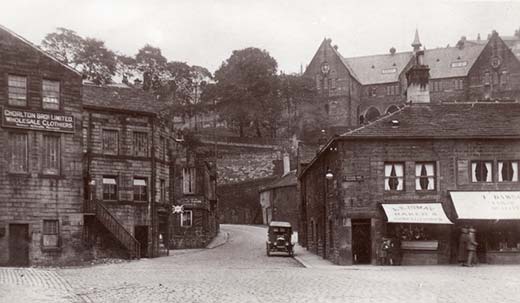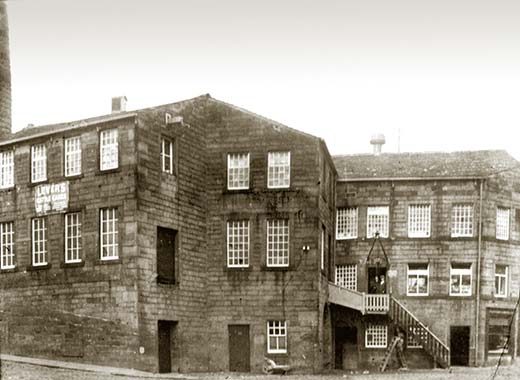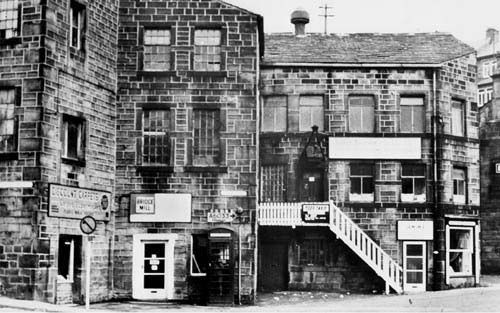BRIDGE MILL IS 700
A potted history of Bridge Mill and Hebden Bridge

FIRST THE BRIDGE
– a vital link in the ancient Halifax to Burnley packhorse way
The origins of the first bridge across the Hebden are lost in the mists of time. Built of timber it probably stood very close to where this mill is now situated, possibly in the location now occupied by the much later Victorian (1892) structure next door. In medieval times most inhabitants of this area avoided the low lying, swampy valley floor and chose to live on the 'tops', descending only where necessary to cross the fast flowing tributary streams, such as the Hebden, by fords or simple timber bridges.
Heptonstall and Wadsworth were already developing as populous and prosperous settlements, known as Townships rather than villages on account of their mixed economy based on the domestic manufacture of woolen cloth in addition to their small scale family farming. Their Saxon heritage, as yet undisturbed by the Norman invasion of Southern England (1066), was more democratic and lacked any semblance of feudal estates.
The very steep packhorse ways linking these two townships remain in evidence today and may be explored on foot by those with sufficient stamina! That descending the Wadsworth hillside is much narrowed but remains as a set-paved footpath down the Birchcliffe hillside adjacent to the arched bulk of Stubbings School visible high above the town centre to the north. Its counterpart, the extremely steep 'Buttress', probably steeper today at the lower part than when first built, climbs from the second Hebden Bridge, now referred to as the 'Old Bridge', built in 1510 to replace the deteriorating timber structure.

Circa 1920s: Bridge Mill to the left
Then there was The Mill
Following the Norman invasion and subsequent 'Harrying of the North' (1087), Saxon landlords were dispossessed and lands distributed to Norman noblemen. Most had little interest in their holdings in the wild Pennines, apart from hunting opportunities, and transferred their management to various ecclesiastical foundations. Some of these, further to the north, eventually grew rich enough from sheep ranching and sales of wool, to found magnificent abbeys - but not the Calder valley, handed to the Priory of Lewes.
Steep-sided, densely forested, with only barren moorland above, the valley had little practical value and remained largely undeveloped apart from the Erringden Deer Park to the south of where the town stands today. Homesteaders moved in and hamlets grew up on more favorable south facing sites such as Heptonstall, Wadsworth and Midgely, as well as around the deer park, such as Palisade (now corrupted to Palace) House and Park Fold.
The swampy valley floor remained virtually unoccupied until 1314 when the Prior of Lewes, acting on behalf of the Lord of the Manor gave consent to Sir John de Thornhill (Knight) to impound the river and construct a mill on the Wadsworth bank of the river between Wadsworth and Heptonstall.
As was the custom of the day, that mill was almost certainly built as close as possible to the pre-existing timber bridge to enhance its potential trade. Two copies of the actual written agreement survive to this day in the archives at Leeds and Lewes. The weir, goit system and remnants of the original walls of the old mill also remain today, encapsulated within the present structure. The 1314 mill occupied much of the area now used as the Innovation Café -Bar, with the waterwheel and goit system being entirely external.
On Sir John's untimely death, only a year after the mill was built, his widow passed the tenancy to 'Stephen the Miller', who figures prominently in the court rolls of the day, suing others for 'setting up their own stones' i.e., grinding their own corn (oats) or being sued for letting his sheep trample land belonging to his neighbours. He even had a dispute with the Lord of the Manor over who should pay for the substantial damage to the mill following the great flood of 1336. Nothing changes!
The mill was greatly extended over the years, upwards and outwards in every direction, particularly in the mid-nineteenth century, when it was converted to textile production. At this time a steam engine house and chimney were added (now the Innovation shop premises) to supplement the power of the waterwheel.
However the ancient water power system actually outlasted this later source of power and is still operating today. Freehold of the mill remained with the Lords of the Manor until 1895, when purchased by Messrs Greenwood and Pickles, clothing manufacturers of Hebden Bridge. They operated mainly on the upper floors, sub-letting the bulk of the ground floor to a variety of other uses - a smithy where the Innovation shop is today, with a sweet shop adjacent next to the bridge, and a Tripe shop occupying the position of the present toy shop, much patronized during the 1939-45 war when almost all food was rationed apart from such tasty items as tripe, elder, cowheel and other offal. Queues formed in the street outside the then sash window through which sales were made.
Greenwood and Pickles operated throughout the war years, running their sewing machines on direct current electricity powered by the waterwheel to overcome power shortages on the national grid and help the war effort - and continued to do so until closure in 1956 when the mill was abandoned to its fate - vandalism, wet and dry rot.
Then there was the Town:
For over 300 years, through the Great Plague, its lengthy aftermath and up to the Civil War of 1645-48 little, if any, further building took place on the floodplain. The mill stood alone throughout this period, visited by farmers from the hillsides, seeking to have their crops of oats dried and ground for the production of havercakes (oatcakes), staple diet of the local population at this time, and the increasing numbers of packhorse trains carrying wool, yarn or cloth to and from market.
Heptonstall built the first Cloth Hall in Yorkshire on the edge of its ancient churchyard in 1545, establishing its position in the trade. As traffic increased, the old timber bridge suffered increasing wear and tear. A fund was set up to raise funds for a new and more substantial replacement, built in 1510 and remaining intact today, known incorrectly as the 'Old Bridge', a little further downstream. This required a small extension of the Wadsworth packhorse trail and a realignment of the lower part of the 'Buttress'.
This new 'Old' Bridge has several pedestrian refuges to which people could flee at the first sound of approaching packhorse bells, to avoid being tipped over the parapet by the bulky panniers of the heavily laden pack ponies. It was also built with three arches, two to span the river and a third apparently on dry land today and occupied by the riverside walk, but originally to span the tail goit from Hebden Bridge Mill which, as the town grew was increasingly built over and obscured.
With improved drainage techniques in the 17th century, farming began to spread onto the flatter land. Kings Farm was built immediately adjacent to the mill in 1657 and, due to the potential of growing passing trade, soon also began to serve as an Inn, surviving successfully today as The White Lion Hotel with recently refurbished en-suite bedrooms and holiday 'Courtyard Cottages' to let. Soon after, other hostelries opened --- the Shoulder of Mutton, White Swan, and Hole in the Wall, said by some to be so called following damage sustained during a Civil War skirmish in the town in November 1646, when, it is said, more soldiers drowned trying to cross the flooding river than were shot.
The town now grew rapidly as a centre of the textile industry, eventually taking its name from the bridges and mill at its core. Packhorse ways were superseded by turnpikes, one of the earliest of which ran along the valley to the newly named Commercial Street and directly to the door of the White Lion, thence via the 'Old' Bridge to the Buttress, Heptonstall and Burnley, or, Hebble End and Horsehold to Todmorden and Rochdale. Turnpike trusts were followed by the Canal Trusts and the Railways, respectively 1795 and 1840 in Hebden Bridge, keeping it at the forefront of new technology and communications as a major manufacturing centre for the production of fustian cloth (see the monument in St Georges Square) and ready-made clothing, known variously as Fustionopolis or Trouser-town.
Industry in the town peaked in the early 1890's with a slow decline until the 1950/60's when it was almost wiped out over a ten year period. Thirty-three factories closed forever. People left to seek work elsewhere. Dereliction, depopulation and despair left a ghost town in its wake, abandoned by governments of all colours. But those who prematurely wrote off this area overlooked one very important asset which remained - the tenacity, determination and energy of those local people who remained and strove to reinvent the town and prepare it for a new future.

Bridge Mill 1920
The Fourth Dimension – Revival and Relaunch:
The 12th May 1965 saw the start of a new crusade by local residents to fight back against the neglect, dereliction and disorder brought about by the widespread demoralisation. A public meeting called in the former Civic Hall on Crown Street (now the Crown Hotel) attracted over 100 people who agreed a programme of voluntary work to enhance the image of the town and generate increased local pride of place. Week-end working parties were well attended and over the next couple of years thousands of new trees were planted in and around the town; buildings cleaned to expose the golden stonework beneath the years accumulation of industrial grime; years-worth of rubbish removed from the river and campaigns mounted for clean air and water.
A 4-part strategy developed to – clean up the local environment and present a more positive image; promote events to attract visitors and tourists; convert visitors to full-time residents; and, lastly, to safeguard derelict industrial buildings for conversion to future employment opportunities.
The strategy soon paid off well. The clean-up proved popular and was well supported. Events brought much press and TV coverage. Visitor numbers began to build and increasingly sought to take advantage of low property prices in an area becoming increasingly attractive.

Bridge Mill - early 1970s
The first to come became known as the Hebden Bridge hippies. Reg and Marion (where are they now?) and the Foster Clough hippies and Queens Terrace squatters; interesting and creative people, they brought much added value to the area. The general trend was upwards and where the hippies pioneered, larger numbers of young professionals from Manchester and Leeds began to follow, bringing their own cultural contributions, helping to build the image of Hebden Bridge as a somewhat offbeat artistic and creative centre.
Its annual Arts Festival, Gallery Trail, music venues and opportunities for active participation in all manner of activities are now widely known and appreciated. In recent years, the town has won many awards and accolades, including the British Airways Inflight Magazine, 'Funkiest Town in Europe'; The New Economics Foundation, 'Least Cloned Town in Britain'; and the Academy of Urbanism, 2011 award for the 'Best Small Town in Britain and Ireland'! The relatively recent partnership project between Calderdale Council and the Town Partnership to pedestrianise and landscape a large part of the central area has given a boost to the regeneration initiative.
Safeguarding former large industrial buildings and attracting new employment activities has proved to be more challenging but is also making startling progress. One of the first steps was the formation in 1979 of Pennine Heritage Ltd by a group of local conservationists, including some from the former Calder Civic Trust, as an active development trust and registered charity. Taking on the challenge of the largest redundant abandoned mill in town, the five storey Nutclough Mill, a monument to the early producer-cooperative movement. Over £1M was raised to rescue and adapt this building to industrial re-use. Now occupied by Calrec Audio Ltd, not only has an important historic building been saved, but also around 150 hi-tech jobs for local people. This exemplifies the purpose of the Pennine Heritage Trust and those volunteers who continue to manage its activities. (For further information about its current project see www.pennineheritage.org.uk)
HEBDEN BRIDGE MILL – The Central Project
Possibly the pioneering project focusing attention on the need to save such structures and the benefits to be obtained is the restoration of Hebden Bridge Mill itself. This building, by far the oldest in the town, situated at its core, having given its name to the whole settlement, was, in 1972 threatened with demolition. To save it from this sad fate, the mill was purchased by its current owner, the former chairman of Calder Civic Trust and instigator of Pennine Heritage. The long process of recovery began. Unable to raise external finance, progress was slow and depended mainly on 20 hour DIY week-ends!
Gradually, area by area, the whole building has been brought back into use to support a growing family of activities, including shops and a café/bar on the ground floor with a restaurant above and a variety of craft enterprises on the upper level. The water wheel was restored as a project for the millennium and, in 2010, plans were prepared to utilise water and solar power rather than rely on the national grid. Two years were required to obtain the necessary planning consents. 2012 was spent fighting the floods and, at last, 2013 saw the construction of an Archimedes screw turbine in the river which, together with the water wheel generates electricity, plus a water source heat pump and solar panels to provide hot water and central heating. All lighting (320 bulbs) have been changed to LED's to cut power usage and the final part of the strategy was the purchase of a small electric car, chargeable from the river turbine for fuel both free of cost and pollution
In the absence of any grant aid or external funding, your patronage over the years has helped us restore this ancient mill, now listed as a building of historic importance.
From 2014, in time for our 700th birthday celebrations, you will know that it is not costing the earth to shop or eat and drink at Innovation, with our sustainable, carbon-free, eco-friendly energy supplies and goods.
With thanks to David Fletcher, and Pennine Heritage for the older photos
Last updated: 1st September 2014

